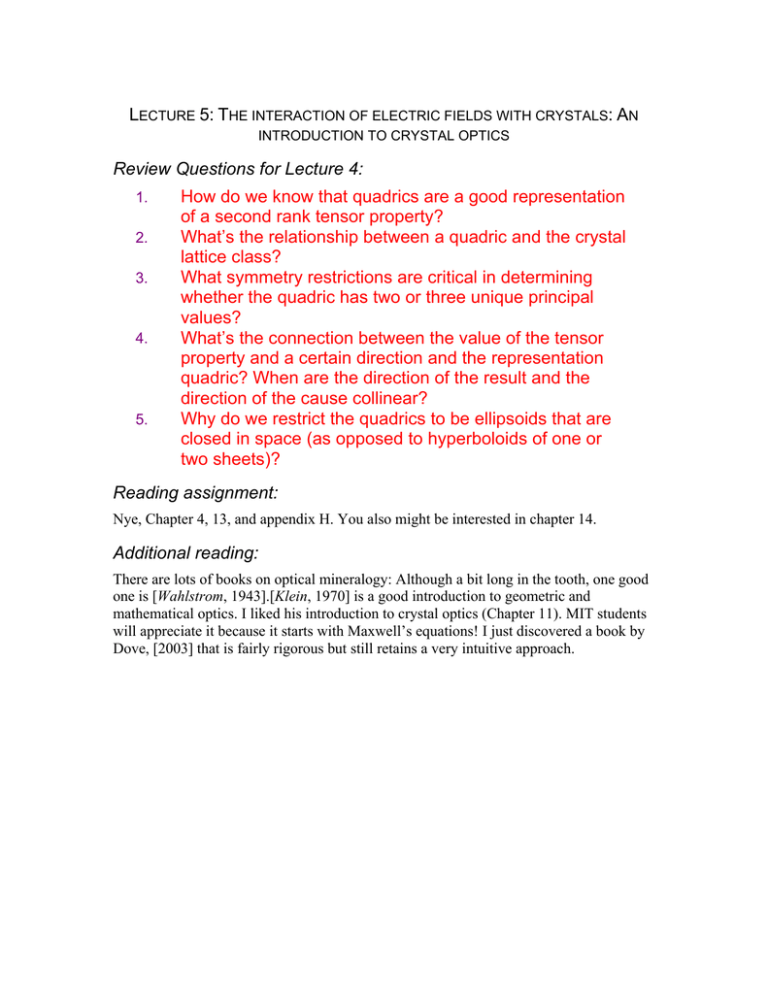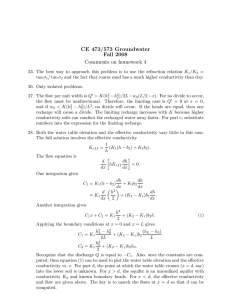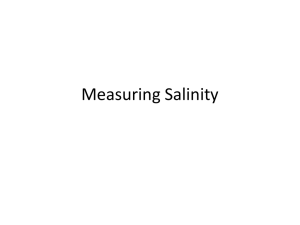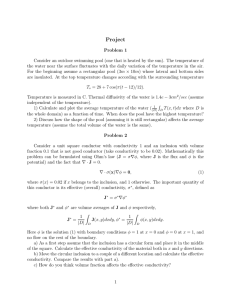L 5: T :
advertisement

LECTURE 5: THE INTERACTION OF ELECTRIC FIELDS WITH CRYSTALS: AN INTRODUCTION TO CRYSTAL OPTICS Review Questions for Lecture 4: 1. 2. 3. 4. 5. How do we know that quadrics are a good representation of a second rank tensor property? What’s the relationship between a quadric and the crystal lattice class? What symmetry restrictions are critical in determining whether the quadric has two or three unique principal values? What’s the connection between the value of the tensor property and a certain direction and the representation quadric? When are the direction of the result and the direction of the cause collinear? Why do we restrict the quadrics to be ellipsoids that are closed in space (as opposed to hyperboloids of one or two sheets)? Reading assignment: Nye, Chapter 4, 13, and appendix H. You also might be interested in chapter 14. Additional reading: There are lots of books on optical mineralogy: Although a bit long in the tooth, one good one is [Wahlstrom, 1943].[Klein, 1970] is a good introduction to geometric and mathematical optics. I liked his introduction to crystal optics (Chapter 11). MIT students will appreciate it because it starts with Maxwell’s equations! I just discovered a book by Dove, [2003] that is fairly rigorous but still retains a very intuitive approach. THE INTERACTION BETWEEN ELECTRIC FIELDS AND CRYSTALS: CONDUCTION MECHANISMS: Depending on the crystal bonding, the thermodynamic conditions (temperature, pressure, and fugacity and chemical potential of various species) crystals can respond to the imposition of an electric field in a variety of ways. Two of the most important responses are the initiation of an electric current (as happens in conductors) or the creation of electric polarization (e.g. non-conductors). Conductors can be further classified by the identity of the species that carries the charge in the current: electrons or ions. Ionic conduction Ionic conduction is common when ions are present in solution. Sea water or electrolytic batteries are good examples of ionic conductors. But, ionic conduction can also occur in crystals if the temperature is high enough for ions to be mobile by some solid-state process like diffusion. Below we consider the example of ionic conduction in olivine at high temperatures. Electronic conduction For electronic conduction to occur, there must be loosely bonded electrons present that can be easily mobilized. Clearly, the electronic configuration is controlled by the bonding type and the chemical identity of the species that make up the crystal. Intuition built from common experience suggests that metallic bonding, hydrogen or van der Waal bonding might provide a source (and sink) for loosely bound electrons. Graphical representations of the electron states around a nucleus are useful in rationalizing the difference between non-conductors and conductors. CONDUCTIVITY AND RESISTIVITY IN MINERALS Tensor description of conductivity and resistivity: j = σE j i = σ ij E j (1) E j = ρ ji j i (2) or alternatively, E = ρj The second equation is simply an intensive form of Ohm’s law. The units of rho and sigma are ohm•meter and Siemens/meter respectively. Because the conductivity (or the resitivity) relates one vector to another, if the material is anisotropic the property is a tensor. The tensor can be shown to be symmetric by the use of Onsager’s principle. Thus, conductivity and resistivity in minerals are 2nd rank, symmetric tensor properties. There are three principal values and three principal directions. The properties may be represented as quadric surfaces. Those quadrics have all the properties described in lecture 4. 108 106 Metals Conductivity of some minerals and rocks ([Adapted from Guéguen and Palciauskas, 1994] 100 10-2 Graph Sulfides 102 10-4 Oxides 10-6 10-8 10-10 10-12 10-14 10-16 10-18 Silicates Electric Conductivity (s/m) 104 Image removed due to copyright reasons Model: Both the relative distances between the ions and the density of electron states are likely to be different depending on crystallographic direction. Thus, one might expect conductivity and resistivity to depend on the direction in which the voltage gradient is applied. To gain some insight into the anisotropy consider the following model. 1Ω 1 kΩ E What will be the resistivity in a direction parallel to the 1 ohm resistors? In the direction parallel to the 1 k ohm resistors? In some arbitrary direction in between? What will the indicatrix look like? What does the conductivity tensor look like? What are the prinicipal directions? Example: Electronic conduction in graphite Ore minerals are often good conductors and, hence, electrical methods are often used to sense prospective ore deposits. Graphite is also a relatively good conductor when the voltage drop is applied in the basal plane. Apparently there is a high density of loosely bound electron energy states available for conduction in that direction. Schematically: 1.42Å 3.35Å In the basal plane, (0001) the resistivity is relatively low, but perpendicular to the plane (parallel to <0001>),it is greater by a factor of 1000. What is the shape of the resistivity indicatrix? Does it have two or three non-unique principal values. In what crystal directions do they lie? The effect of graphite on the conductivity of the lower crust may be quite striking. This is particularly true because the graphite may be produced by reduction from a fluid phase and end up coating crack or pore surfaces. The graphite then becomes a connected network of conductors all throughout the rock See [Duba et al., 1994; Roberts et al., 1999] for some interesting applications. Example: Conductivity in olivine Ionic conductivity is common in solutions, but it is also possible whenever temperatures are great enough that ions may diffuse within the crystal. The electrical conductivity of rocks in general, and olivine in particular is important in using remote measurements of electrical properties to probe the interior of the Earth. As we have seen, conductivity can be strongly aniosotropic in each crystal. It is also a strong function of temperature, pressure, and chemical potentials. As is true of many properties, reactions, or transformations that involve breaking chemical bonds, the temperature dependence of conductivity in some direction s may be expressed as an exponential: σ s = σ so exp− Q RT That is, conductivity is thermally activated. Changes in slope in a plot of log (conductivity) as a function of 1/T may indicates changes in the identity of the charge carrier or the mechanism by which it is being transported in the crystal. Consider the diffusivity of Ni in olivine as a proxy mechanism for the charge transfer. The tensor relation for diffusion is quite similar to the conductivity relation (i.e. Ohm’s law and Fick’s first law are similar). J = −D ∇c dc J i = −Dij dx j The diffusion coefficient has the following values along the a, b, and c axes: [100] [100] [100] 2 D100 = 4.4i10−14 cm D100 = 3.35i10 −14 cm D100 = 124i10 −14 cm s 2 s 2 s On the next page is a drawing of the crystal structure of olivine. Can you rationalize these values?[Zoltai and Stout, 1984] TEMPERATURE DEPENDNCE OF OLIVINE [Adapted from Duba et al., 1990; Duba and Constable, 1993; Wanamaker and Duba, 1993b; Wanamaker and Duba, 1993a] Electrical Conductivity in Olivine 6.9 1176 6.7 1219 [010] 1265 104/T (K-1) [100] [001] 6.3 1314 6.1 1366 5.9 1422 Temperature (oC) 6.5 CO2:CO = 30:1 1401 5.7 5.5 -5.2 -4.8 -4.4 -4.0 -3.6 -3.2 -2.8 1545 -2.4 Log (σ-S/m) BIBLIOGRAPHY Dove, M.T., Structure and Dynamics: An Atomic View of Materials, 334 pp., Oxford University Press, Oxford, 2003. Duba, A., and S. Constable, The electrical conductivity of lherzolite, Journal of Geophysical Research, B, Solid Earth and Planets, 98 (7), 11,885-11,899, 1993. Duba, A., S. Heikamp, W. Meurer, G. Nover, and G. Will, Evidence from borehole samples for the role of accessory minerals in lower-crustal conductivity, Nature (London), 367 (6458), 59-61, 1994. Duba, A.G., R.N. Schock, E.L. Arnold, T.J. Shankland, A.G.e. Duba, W.B.e. Durham, J.W.e. Handin, and H.F.e. Wang, An apparatus for measurement of electrical conductivity to 1500 degrees C at known oxygen fugacity The brittle-ductile transition in rocks, Geophysical Monograph, 56, 207-209, 1990. Guéguen, Y., and V. Palciauskas, Introduction to the Physics of Rocks, 294 pp., Princeton University Press, Princeton, NJ, 1994. Klein, M., Optics, 647 pp., John Wiley and Sons, New York, 1970. Roberts, J.J., A.G. Duba, E.A. Mathez, T.J. Shankland, and R. Kinzler, Carbon-enhanced electrical conductivity during fracture of rocks, Journal of Geophysical Research, B, Solid Earth and Planets, 104 (1), 737-747, 1999. Wahlstrom, E.E., Optical crystallography, 205 pp., John Wiley and Sons, New York, 1943. Wanamaker, B.J., and A.G. Duba, Electrical conductivity of polycrystalline olivine containing a silicate glass, Geophysical Research Letters, 20 (19), 2107-2110, 1993a. Wanamaker, B.J., and A.G. Duba, Electrical conductivity of San Carlos Olivine along [100] under oxygen- and pyroxene-buffered conditions and implications for defect equilibria, Journal of Geophysical Research, B, Solid Earth and Planets, 98 (1), 489-500, 1993b. Zoltai, T., and J.H. Stout, Mineralogy: Concepts and Principles, 505 pp., Macmillan Publishing Company, New York, 1984.





